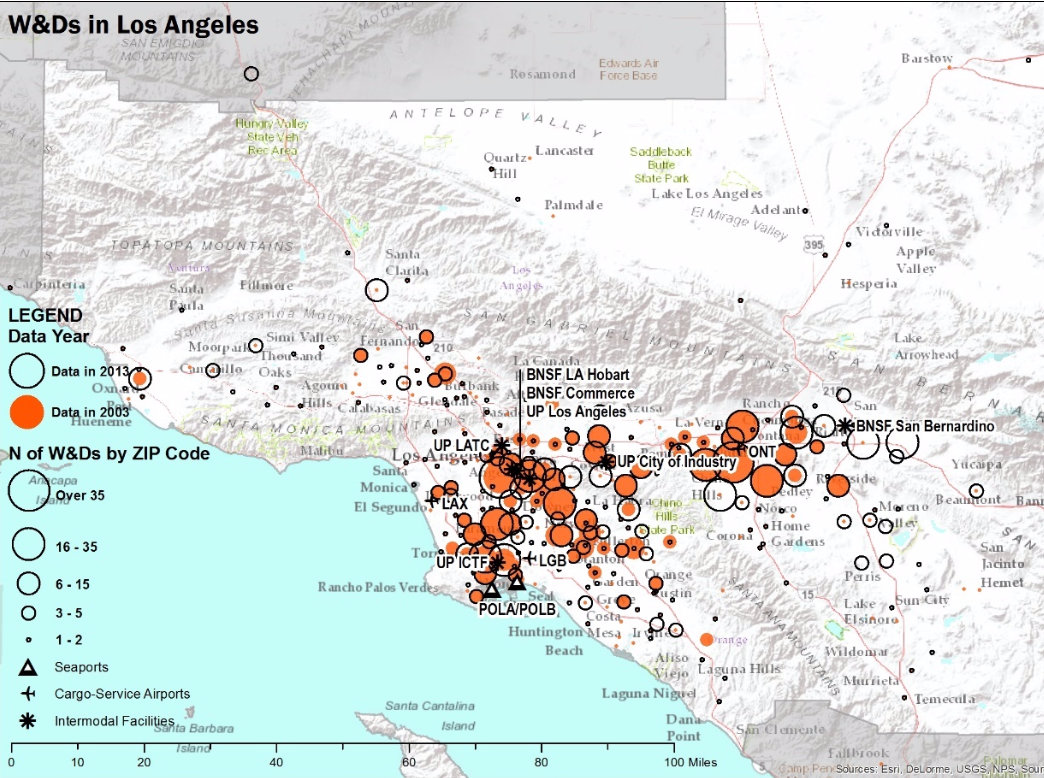News | METRANS Research Analyzes Spatial Dynamics of Warehousing and Distribution in California
Stop the VideoNews

METRANS UTC
METRANS Research Analyzes Spatial Dynamics of Warehousing and Distribution in California
Friday, March 17, 2017
by By Rui Zhang, MPL 2018

Source: Draft Paper "Spatial Dynamics of Warehousing and Distribution in California" by Genevieve Giuliano and Sanggyun Kang
California’s large and dynamic economy—together with its role as a major international trade gateway of the United States—generates large volumes of freight flows and an active warehousing and distribution (W&D) sector. The location of W&D activities has significant implications for freight demand and flows, and thus is a critical element in statewide transportation planning. To document and analyze the location patterns of warehousing and distribution activity in California, METRANS launched a research project led by METRANS Director, Professor Genevieve Giuliano, working with Sanggyun Kang and Jack Yuan, both Ph.D. candidates in Urban Planning and Development at USC’s Price School of Public Policy.
The research was conducted in two parts. The first part used the results of a previous study of four metro areas in California as supportive evidence: a descriptive analysis of W&D trends from 2003 - 2013 using Zip Code Business Pattern Data. Significant findings included decentralization of W&D activity from the major metro areas to adjacent smaller metro areas, and relocation of W&D employment for the largest metro areas, suggesting that larger facilities are locating further from the center.
The second part examines possible explanatory factors associated with W&D location trends, supported by Cross Section Models and the Time Series Model. Findings include that the effect of regional market attributes decreased significantly over the time period. This suggests that although the overall pattern of W&D activity appears to be stable, the W&D industry is quick to adapt to changing market conditions, (and thus, may fluctuate).
Yuan said he was excited to be part of the project: “When you drive along I-10 to the Inland Empire, you will find so many large warehousing facilities. They dramatically change the urban landscape in many neighborhoods,” he noted. “It is really interesting to work on a research project that describes and explains the spatial placement of those warehouses.
Kang drew two interesting observations from the research. One is “the stability in the concentration of warehousing functions in large metro areas, i.e., areas which are not only major trade gateways with the richest transport infrastructure but also significant goods production/consumption markets with large labor pools and linked industries.” The second is “the spillover of warehouses beyond the metro area boundary into adjacent counties of the Los Angeles and San Francisco CSAs (Combined Statistical Areas).”
Kang added that, while more detailed research is necessary to verify whether these warehouses are linked to the logistics operations in the two metro areas, the existing research is particularly helpful to future freight policy making and statewide transportation planning.
Rui Zhang
Rui Zhang is a Master of Planning student in the Price School of Public Policy at the University of Southern California with transportation concentration. She is a research assistant at the METRANS Transportation Center and is currently working on a METRANS research project titled “Managing the Impacts of Freight in California”. She plans to start a career on transportation planning with a focus on GIS spatial analysis. She can be reached at [email protected].
News Archive
- December (1)
- November (6)
- October (4)
- September (2)
- August (3)
- July (4)
- June (3)
- May (7)
- April (8)
- March (11)
- February (8)
- January (7)
- December (7)
- November (8)
- October (11)
- September (11)
- August (4)
- July (10)
- June (9)
- May (2)
- April (12)
- March (8)
- February (7)
- January (11)
- December (11)
- November (5)
- October (16)
- September (7)
- August (5)
- July (13)
- June (5)
- May (5)
- April (7)
- March (5)
- February (3)
- January (4)
- December (4)
- November (5)
- October (5)
- September (4)
- August (4)
- July (6)
- June (8)
- May (4)
- April (6)
- March (6)
- February (7)
- January (7)
- December (8)
- November (8)
- October (8)
- September (15)
- August (5)
- July (6)
- June (7)
- May (5)
- April (8)
- March (7)
- February (10)
- January (12)















